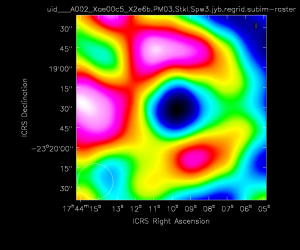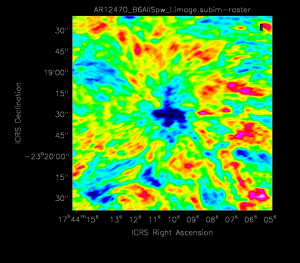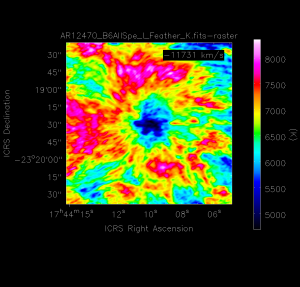Sunspot Band6 Feathering for CASA 6.5.4: Difference between revisions
No edit summary |
|||
| Line 19: | Line 19: | ||
<source lang='python'> | <source lang='python'> | ||
# In CASA | # In CASA | ||
int_base = 'AR12470_B6AllSpw_I' # basename of the | int_base = 'AR12470_B6AllSpw_I' # basename of the interferometric image | ||
sd_img_base = 'uid___A002_Xae00c5_X2e6b.PM03.StkI.Spw3' | sd_img_base = 'uid___A002_Xae00c5_X2e6b.PM03.StkI.Spw3' # basename of the single dish image | ||
# basename of the | out_base = 'AR12470_B6AllSpw_I_Feather' # basename of the combined products | ||
out_base = ' | |||
</source> | </source> | ||
Revision as of 19:00, 11 April 2024
Last checked on CASA Version 6.5.4
Overview
This guide features CARTA, the “Cube Analysis and Rendering Tool for Astronomy,” which is the new NRAO visualization tool for images and cubes. The CASA viewer (imview) has not been maintained for a few years and will be removed from future versions of CASA. We strongly recommend using CARTA, as it provides a much more efficient, stable, and feature rich user experience. A comparison of the CASA viewer and CARTA, as well as instructions on how to use CARTA at NRAO, is provided in the CARTA section of the CASA docs.
This portion of the Sunspot Band6 guide covers the combination process between the synthesized solar image and the full-sun image obtained with the TP array. It is the final step after: 1) the calibrating the IF visibility data; 2) imaging the IF data; 3) calibrating and imaging the single-dish data. If you wish, you may skip parts 1 and 2, download the calibrated data package, Sunspot_Band6_CalibratedData.tgz, and complete part 3.
If you completed parts 1 and 2, we assume that you are working in the directory 'Sunspot_Band6_UncalibratedData'. If you skip parts 1 and 2, and use the provided calibrated data, we assume that the working directory is 'Sunspot_Band6_CalibratedData.'
Obtain the RA/Dec Coordinate of the Sun Center at the Reference Time
Before starting the combination process on CASA, we need to know the RA/Dec coordinate of the sun center at the reference time that is used for the image synthesis, because the observing time of the TP-array is not the same as the reference time exactly. The Sun was moving on the RA/Dec coordinate frame during the gap between the times. To combine the synthesized image with the full-sun image obtained from the TP array, we need to shift the coordinate of the full-sun image based on the coordinate of the sun center at the reference time. Hence, we obtain the solar coordinate from the JPL's HORIZONS system[1].
The reference time in this tutorial is 19:49:00UT, December 18 2015. At the time, the RA/Dec coordinate of the sun center estimated by JPL's HORIZONS system is RA: 266.01898 degree, Dec: -23.38648 degrees.
Prepare the Single-Dish Data for Combination
We start the process on CASA by defining some names of the data.
# In CASA
int_base = 'AR12470_B6AllSpw_I' # basename of the interferometric image
sd_img_base = 'uid___A002_Xae00c5_X2e6b.PM03.StkI.Spw3' # basename of the single dish image
out_base = 'AR12470_B6AllSpw_I_Feather' # basename of the combined products
We shift the coordinate of the full-sun map created from the single-dish data, based on the RA/Dec coordinate obtained in the previous section, as follows.
# In CASA
import numpy as np
sun_ra = str(266.01898 * np.pi/180.)
sun_dec = str(-23.38648 * np.pi/180.)
imhead(imagename=sd_img_base+'.rescl', mode='put', hdkey='crval1', hdvalue=sun_ra)
imhead(imagename=sd_img_base+'.rescl', mode='put', hdkey='crval2', hdvalue=sun_dec)
The unit of the full-sun map is Kelvin. On the other hand, the unit of the synthesized image is Jy/beam. So, the conversion of the unit has to be done. In the tutorial, we convert the unit of the full-sun image to Jy/beam, using the following commands.
# In CASA
crval4S= imhead(sd_img_base+'.rescl', mode='get',hdkey='crval4')
freqSD = crval4S['value']
sbema = imhead(sd_img_base+'.rescl', mode='get',hdkey='beammajor')
sbemi = imhead(sd_img_base+'.rescl', mode='get',hdkey='beamminor')
sbmajor = sbema['value']
sbminor = sbemi['value']
convKJb = str(13.6 * (300./(freqSD/1.e9))**2. * (1./sbmajor)*(1./sbminor))
immath(imagename=sd_img_base+'.rescl', expr='IM0/'+convKJb, outfile=sd_img_base+'.jyb.im')
imhead(imagename=sd_img_base+'.jyb.im', mode='put', hdkey='crval3', hdvalue=['I'])
imhead(imagename=sd_img_base+'.jyb.im', mode='put', hdkey='bunit', hdvalue='Jy/beam')
The result of the process is shown in Figure 1. A look of the image is not changed, but you can find the changing of the values and unit in the 'Sunspot_Band6_SingleDish_for_CASA_4.7' tutorial.
Then we do the re-gridding and trimming to fit the map area to that of the synthesized image. The area of the trimming is set to the same as the CLEAN box, in the tutorial.
# In CASA
#re-griding of SD data
imregrid(imagename=sd_img_base+'.jyb.im', template=int_base+'.image', axes=[0, 1], output=sd_img_base+'.jyb.regrid')
# Trimming to exclude noisy edge regions in the TP image
imsubimage(imagename=sd_img_base+'.jyb.regrid', outfile=sd_img_base+'.jyb.regrid.subim', box='100,100,400,400')
As the final process of the preparation of the single-dish data, we multiply the trimmed image by the primary beam response, as follows.
# In CASA
imsubimage(imagename=int_base+'.pb',outfile=int_base+'.flux.subim',box='100,100,400,400')
immath(imagename=[sd_img_base+'.jyb.regrid.subim',int_base+'.flux.subim'], expr='IM0*IM1', outfile=sd_img_base+'.jyb.regrid.subim.depb')
Prepare the Synthesized Image for Combination
To fit the map area to that of the trimmed single-dish image, we do the trimming for the synthesized image.
# In CASA
imsubimage(imagename=int_base+'.image', outfile=int_base+'.image.subim', box='100,100,400,400')
Combination and Primary Beam Correction
The combining of the maps can be done using 'feathering' task, as the same as the non-solar data.
# In CASA
feather(imagename=out_base+'.image', highres=int_base+'.image.subim',lowres=sd_img_base+'.jyb.regrid.subim.depb')
CAUTION: In this tutorial and the packages of the solar SV data released on 2017/01/18, we use the default parameters of the task, as shown above. As a result, the averaged brightness temperature of the combined image is always larger a few % than the temperature brightness at the same position in the single-dish map, although the values have to be the same basically. It means that you need to tune the “sdfactor" parameter of the task for obtaining consistent images, before using combined images for your science. The detail of the parameter is described in Section 5.6 of “CASA User Reference & Cookbook Release 4.7.0”[2].
After the feathering process, we do the primary beam correction, as follows.
# In CASA
impbcor(imagename=out_base+'.image', pbimage=int_base+'.flux.subim', outfile=out_base+'.pbcor', mode='divide')
To convert the unit from Jy/beam to Kelvin, we use the following commands.
# In CASA
crval4I= imhead(int_base+'.image', mode='get',hdkey='crval4')
freq = crval4I['value']
fbema = imhead(out_base+'.image', mode='get',hdkey='beammajor')
fbemi = imhead(out_base+'.image', mode='get',hdkey='beamminor')
fbmajor = fbema['value']
fbminor = fbemi['value']
convKJb2 = str(13.6 * (300./(freq/1.e9))**2. * (1./fbmajor)*(1./fbminor))
immath(imagename=out_base+'.pbcor',expr='IM0*'+convKJb2, outfile= out_base+'_K.pbcor')
imhead(imagename=out_base+'_K.pbcor', mode='put', hdkey='bunit', hdvalue='K')
Finally, we create the FITS file of the combined and primary corrected map.
# In CASA
exportfits(imagename=out_base+'_K.pbcor', fitsimage=out_base+'_K.fits')
The result of the combining is shown in Figure 4.
Caution: The single-dish images and feathering images in the solar SV data packages (ex. Sunspot_Band6_ReferenceImages.tgz) were not applied the re-scaling to the single-dish data (see Sunspot_Band6_SingleDish_for_CASA_6.5.4#Calibration_.28re-scaling.29_after_Imaging). Please do not use the reference image for your science.



